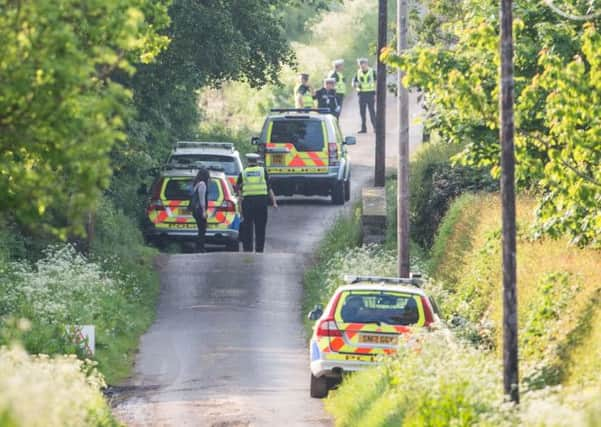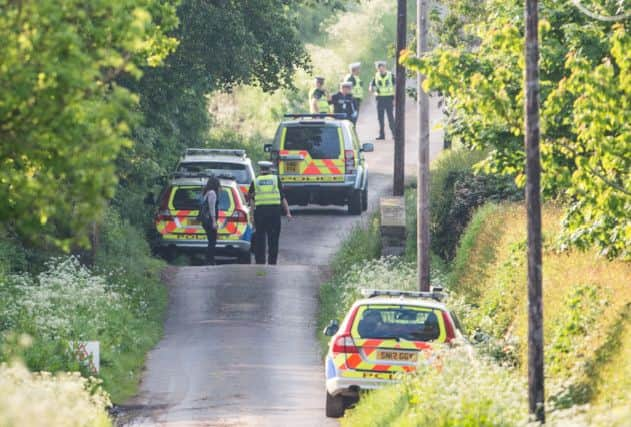Why did Jim Clark Rally continue, police ask


An eyewitness to what is believed to be the worst incident in Scottish rallying history said he thought spectators where the car crashed had moved forward again despite being told to move back from the road by marshals.
Teacher Colin Gracey said the car had ploughed into the onlookers at the Jim Clark Rally in the Borders like a “bowling ball hitting skittles”.
Advertisement
Hide AdAdvertisement
Hide AdThose killed in the crash near Swinton were named last night as Iain John Provan, 64, and Elizabeth Allan, 63, a couple from Barrhead in East Renfrewshire, and Len Stern, 71, from Bearsden in East Dunbartonshire.


The condition of a 61-year-old man hurt in the incident has improved from critical to stable at Edinburgh Royal
Infirmary. However, another 61-year-old man remained in a critical but stable condition in the hospital following the earlier crash, at Eccles, to the south-west of the fatal collision.
The first crash, in which four other spectators were injured, came two hours before the fatal incident, near a humpback bridge near Swinton, just after 4pm on Saturday. The rally, a series of disjointed stretches which was due to finish yesterday, was immediately abandoned after the fatal crash.
A police spokeswoman confirmed that, as part of their investigation, officers will consider whether the event should have been cancelled after the first accident.
Mr Gracey, from Swinton, who has watched the rally for 17 years, said: “I think it was the seventh car and it veered very sharply after the bridge and went into the field, hitting the people who were stood there.
“It was shocking. I was there with my three children, and we go to the same place every year and always watch it from there. It was very traumatic.”
Mr Gracey said a safety car had passed through the area ahead of the rally to tell people to stand at a safe distance.
Advertisement
Hide AdAdvertisement
Hide AdHe said: “A marshal car came through before the stage started and told people to move away from the area. I think people moved but came back.”
Superintendent Phil O’Kane of Police Scotland, asked about why the rally had not been abandoned after the earlier crash, said: “After the first incident at the Eccles section, full consideration was taken of safety, and the organisation committee, in discussion with police and other partners, suspended that part of the rally at that time.
“The decision for a fatal accident inquiry will rest with the Lord Advocate, so we will conduct our investigation thoroughly and report to the fiscal, and then it will be a Crown Office decision.”
Gav Smith, from South Shields, posted on the rally’s Facebook page: “Tragic day. Spectators and competitors alike are well aware of the risks, the best safety measures cannot stop people wanting to be close to the sport they love, that to us is the appeal of rallying.”
The event, which has been staged in the Borders since 1970, is held on closed public roads like one on Mull.
Others are staged on privately owned forest tracks, such as the Snowman Rally in the Highlands.
The Scotsman understands that, in such events, rally drivers are unlikely to face prosecution because road traffic laws are suspended so they can ignore the speed limit.
It also believed rally marshals do not have the power to force spectators to move back from the edge of roads, and their only option if they fear for safety is to call off the event. Police Scotland would only say this would be examined as part of its investigation.
Advertisement
Hide AdAdvertisement
Hide AdMotoring groups praised the safety record of the rally but said any lessons learned must be acted on swiftly.
The Institute of Advanced Motorists (IAM) said it backed UK government plans to make it easier to stage closed-road motoring events to boost local economies.
The proposal would enable local authorities to authorise such car and motorcycle rallies, which currently require an Act of Parliament at Westminster.
Motorsport officials fear the crash could set back the plans. One said: “This has happened at exactly the wrong time”.
Scotland-based IAM policy and research director Neil Greig said: “Whilst an inquiry is clearly needed into what went wrong, we have supported a recent consultation to extend closed-road racing due to the previously excellent safety record of events such as the Jim Clark rally.”
Supt O’Kane said: “The rally is a unique event and the responsibility rests with the organising committee. There is an Act of Parliament specific to the Jim Clark Rally, and all safety considerations are the responsibility of the organising committee.
“But I do know it is well stewarded. Safety is a very big consideration in the planning of it.
“We, as Police Scotland, are involved with that planning as a supporting agency.”
Advertisement
Hide AdAdvertisement
Hide AdAA president Edmund King said: “Our thoughts are with the families and friends of those killed and injured at the Jim Clark Rally.
“Motorsport can be dangerous but we have seen, particularly in Formula One, much can be done and has been done to make it safer. Rally crowds like to get close to the action but it seems that ‘close’ in these incidents was too close. Hopefully, the full investigation will show what can be done in the future to avoid such tragedies.”
Rob Jones, chief executive of the Motor Sports Association (MSA), the sport’s governing body, said: “As with any serious incident, the accidents will be subject to full inquiries by the MSA to ensure any lessons are learned, to assist in the constant drive to provide the highest possible safety standards at all motorsport events.”
A Police Scotland spokeswoman said: “Police can confirm this is a wide-ranging investigation. We are in consultation with the Crown Office regarding the nature of the inquiry.”
About 250 competitors had been taking part in the event, with thousands of spectators watching the action.
In a statement, the rally organisers offered their “heartfelt condolences and sympathy” to all those affected. It said: “Our thoughts are especially with those who have lost family members and to the families of the injured spectators.
“All members of the organising team are in shock and are co-operating fully with Police Scotland to establish the facts.”
Flowers were left yesterday on Swinton village green. One bunch had a card which read: “The sport that we all love is very cruel at times. Deepest sympathy for all concerned. With love, car 180.”
Advertisement
Hide AdAdvertisement
Hide AdJustice secretary Kenny Mac-Askill is expected to make a statement to MSPs tomorrow. He said: “This incident will have come as a tremendous shock to the local community and wider motoring family. Above all, our thoughts are with the family and friends of those affected.”
Jim McGill: Rally fans are bewitched by their love of speed and getting close to the cars
‘What’s the appeal of rallying?” That’s a question I’ve been asked on a number of occasions in the wake of the Jim Clark Rally tragedy.
The answers are varied and numerous: but at their heart lies gaining access, and close proximity to cars travelling at serious, competitive speeds.
Rallying has always been something of a “motorsport for the people”. Access has always been paramount.
Whereas at circuit racing — certainly in the modern era — spectators and fans have been safely corralled behind fencing, at times so far from the action it’s as if the racing was taking part in another county, rallying has always been close-up and personal.
On mainland Europe, in rounds of the World Rally Championship, spectators will still challenge themselves — and each other — to try and touch the cars as they speed past.
Thankfully, there has never been that degree of abandonment by spectators of rallying in Scotland.
Advertisement
Hide AdAdvertisement
Hide AdThey are, by and large, sensible people. Sure, they’ll traipse for miles through forests to catch a glimpse of cars slithering and sliding through a slippery gravel stage, but they know what they’re doing.
Or, at least, the majority do. The sad, tragic and harsh reality is, there are — and, most likely, always will be — spectators who turn up to watch a rally ignorant of the inherent dangers.
Of course, they may not be ignorant: instead they may simply have the opinion that “it’ll never happen to me”.
Consider this: would you go and stand at the edge of a motorway and watch cars driving past you in a straight line, on dry Tarmac, at 70mph? The answer, at least from most sensible people, would be an undebatable “No”.
Yet, despite all the public warnings by rally officials and unpaid volunteer marshals, rally fans insist on trying to get as close as they can to the action, and in doing so ignore the potential safety repercussions and place themselves in danger.
Of course, we do not yet know the full facts about Saturday’s tragedy, but I know from experience spectators will expose themselves to dangers. One of the main attractions of the Jim Clark Rally is that it is the only all-Tarmac event to be held on closed-off public roads on mainland UK.
As a result, the cars often exceed 100mph.
While the crews in the cars are surrounded by a phalanx of safety equipment, spectators — especially in rallying — have no more protection than perhaps a wooden fence, feeble hedge, and the clothes they are wearing.
Would you expose yourself to such danger? That’s an answer only you can give.
• Jim McGill is a Scottish motor sport writer